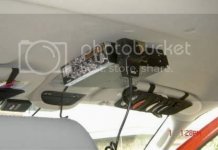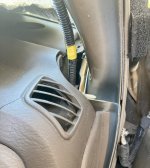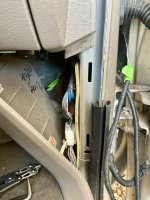Update:
The LED license plate lights did not appear to have any affect on the noise level. There was no real difference when unhooking them. The "patterning" also isn't panning out, but what did pan out...
Using a pocket am/fm/wx weather I was able to sniff out a couple major culprits. Keep in mind this is a dual battery, Cummins TD, no negative lead current monitoring capabilities. I tuned to static and started poking around and discovered what seemed to be tremendous noise radiating off of a negative lead that disappears down to the engine block. The Cummins has an engine control module bolted to the block on the drivers side and this likely appeared to be the power leads down to the unit. I had some snap on ferrites and decided to remove the lead from an engine bay frame ground, and put it directly to the battery. This gave slack to wrap the lead through a ferrite with one loop. The positive also lead got a few ferrites snapped on. I removed the shield of the RG8 coax/power lead to the Alinco DX70 (the radio I've been doing all this with, all along) from the negative battery lead all together. I had terminated the other end of the shield, so there is still that bonding point inside the cab (this shield is NOT the negative lead connection for the radio power, it is simply acting as a shielded conductor).
The next biggest culprit is a control module on the passenger side firewall. I listed in my notes "powertrain" and "transmission" as being both mounted in that area, so I am not sure if they are one in the same yet, but suffice to say the "alternator whine" ain't alternator wine. Its that guy...by a long shot. That bugger is very much the source of the engine speed related whine I get above 16mhz. I peeled open the loom and found what I think are the power leads and snapped a few ferrite onto those, grounds and power. I took a jumper from the battery to the engine bay frame that was sharing the grounds from this module (passenger side battery) and moved it over to a different screw about 10 inches away to try to create physical separation.
I had quite a selection of the snap on ferrite's, so I added a few on the RG8 shield at the battery connection back over on the drivers side. I did a quick course VFO dial spin just to get an idea of any changes, and there is another good notch in the bedpost on noticeable improvement's. I still hear the hash around 13-15 mhz, but the signal bars are reduced, indicating at least a reduction in the RF noise floor, the whine is much reduced but still present, so if nothing else I am confident that I am on the right set of tracks.
Original setup:
Alinco Dx70 powered from fused power in the cab, fed from the drivers side battery, Tarheel II screw driver on the bed. Virtually unusable noise floor above 10 mhz. Hood bonded to firewall frame on pass/drivers side.
Currently:
Alinco Dx70 powered from dedicated, fused, shielded positive with shield bonded at radio, DC noise filter on the positive, negative power lead using nearby vehicle ground, radio chassis bonded, ferrites on the power at the battery connection. AM BCB LPF in line out to the Tarheel II, bonding jumper added at antenna mount to the bed. Ferrites added to engine control module and powertrain/transmission control module power leads, few other ferrites sprinkled in for good luck on the various grounds under the hood. More or less usable across the 4-30mhz which is about what the TH is rated for. I don't really spin the dial much down below 4mhz.
Next steps:
Continue to monitor by using and enjoying the radio on my drives...
Made up a set of bonding jumpers, need to get them installed on bed, exhaust, ect as a matter of course
Explore ideas on shielding the module on the passenger side firewall
Research the ferrite types. Some are bonified correct composition, some are cheap online snap-on's that aren't clearly specific in their type
For anyone searching and finding this, its definitely not for the faint of heart to tackle. The posts here don't really convey the frustration and actual amount of time these few things have actually taken to accomplish. That said, none of this was terribly complicated to do, just need to be committed to keeping track of what worked, what didn't, try one thing at a time and listen to suggestions provided out there by the many folks have already done this.







